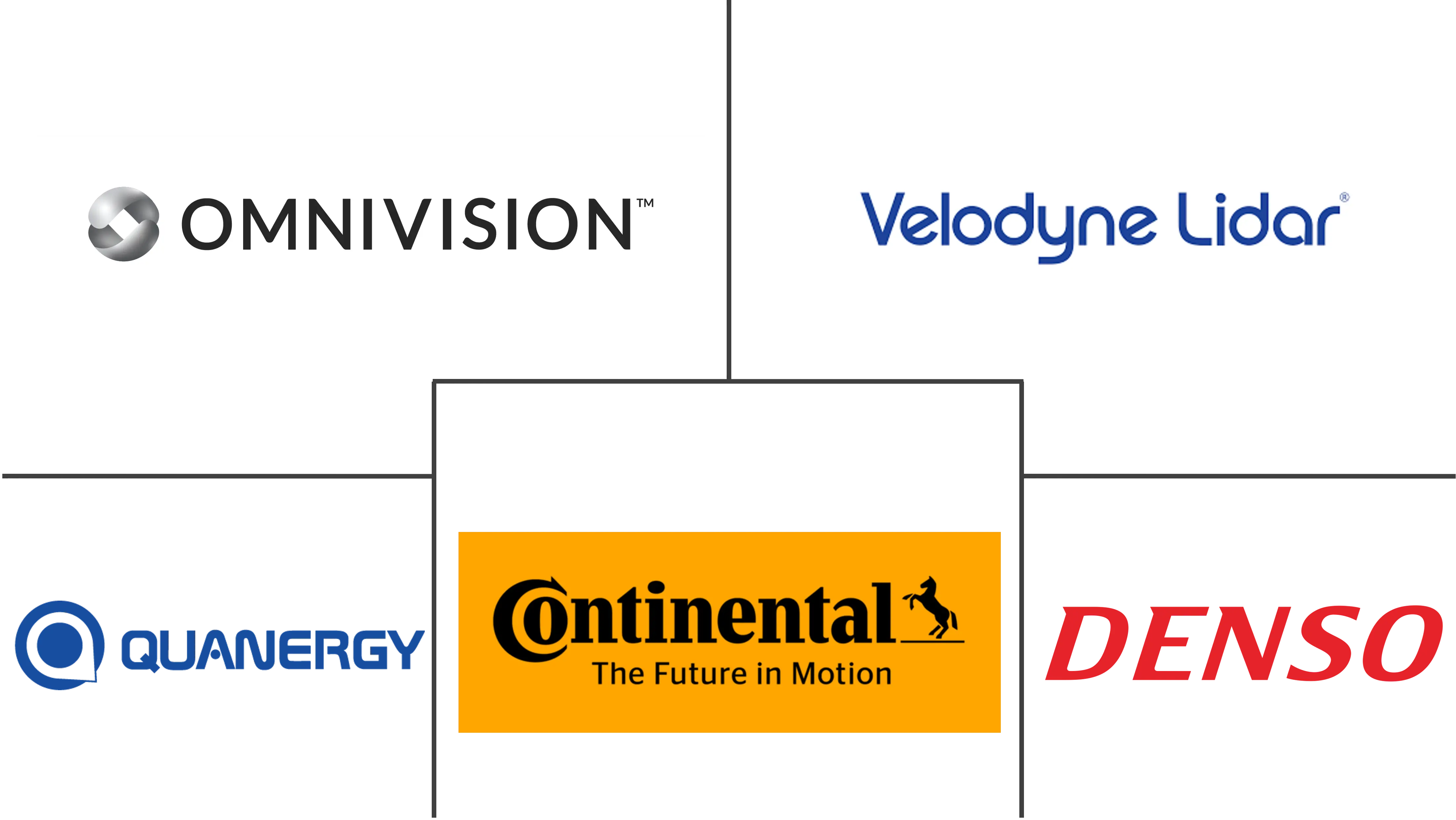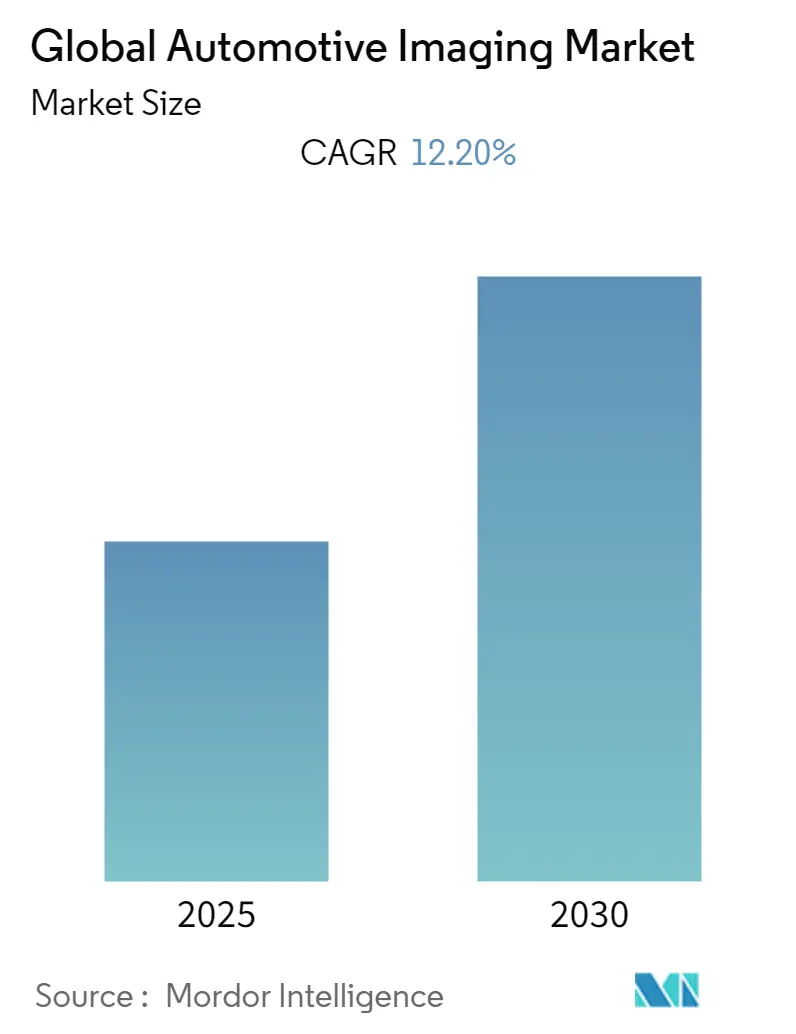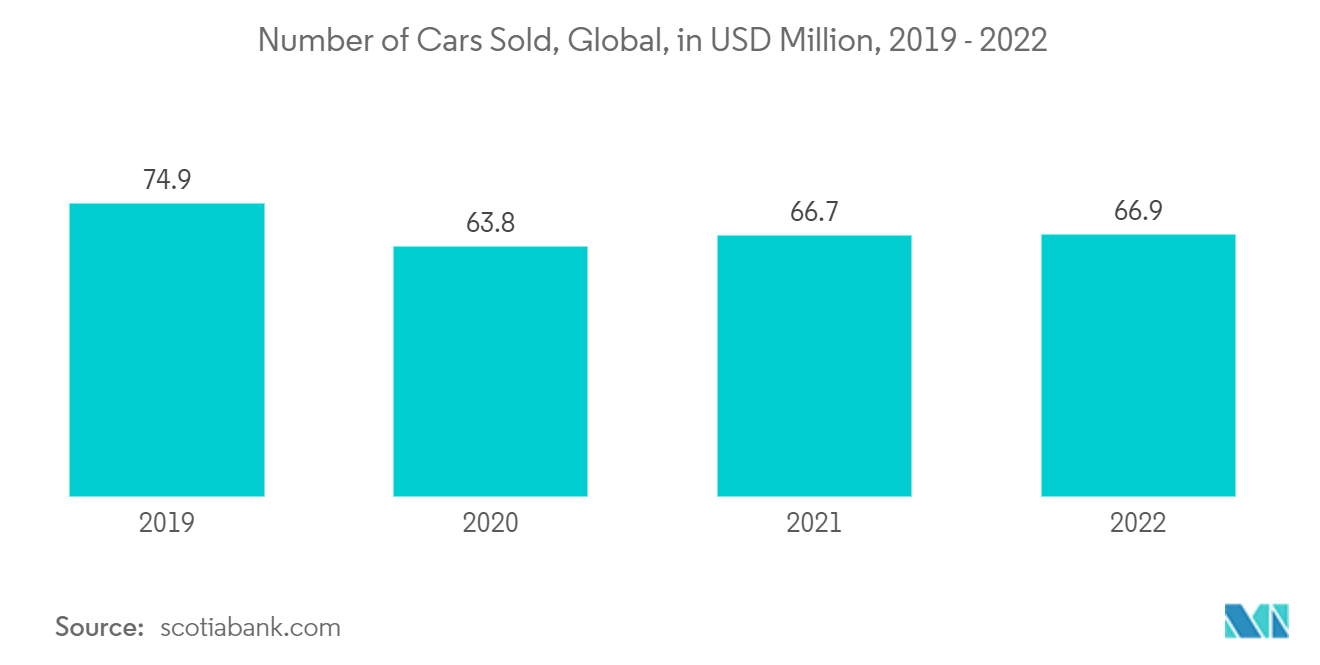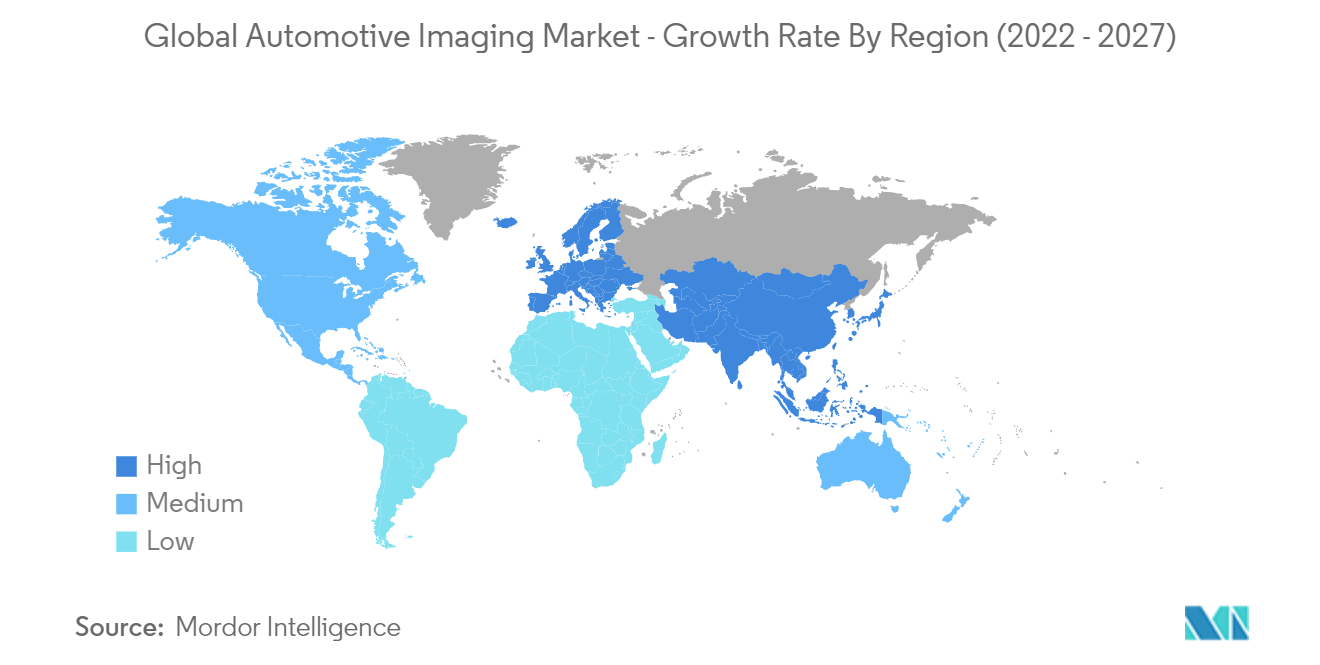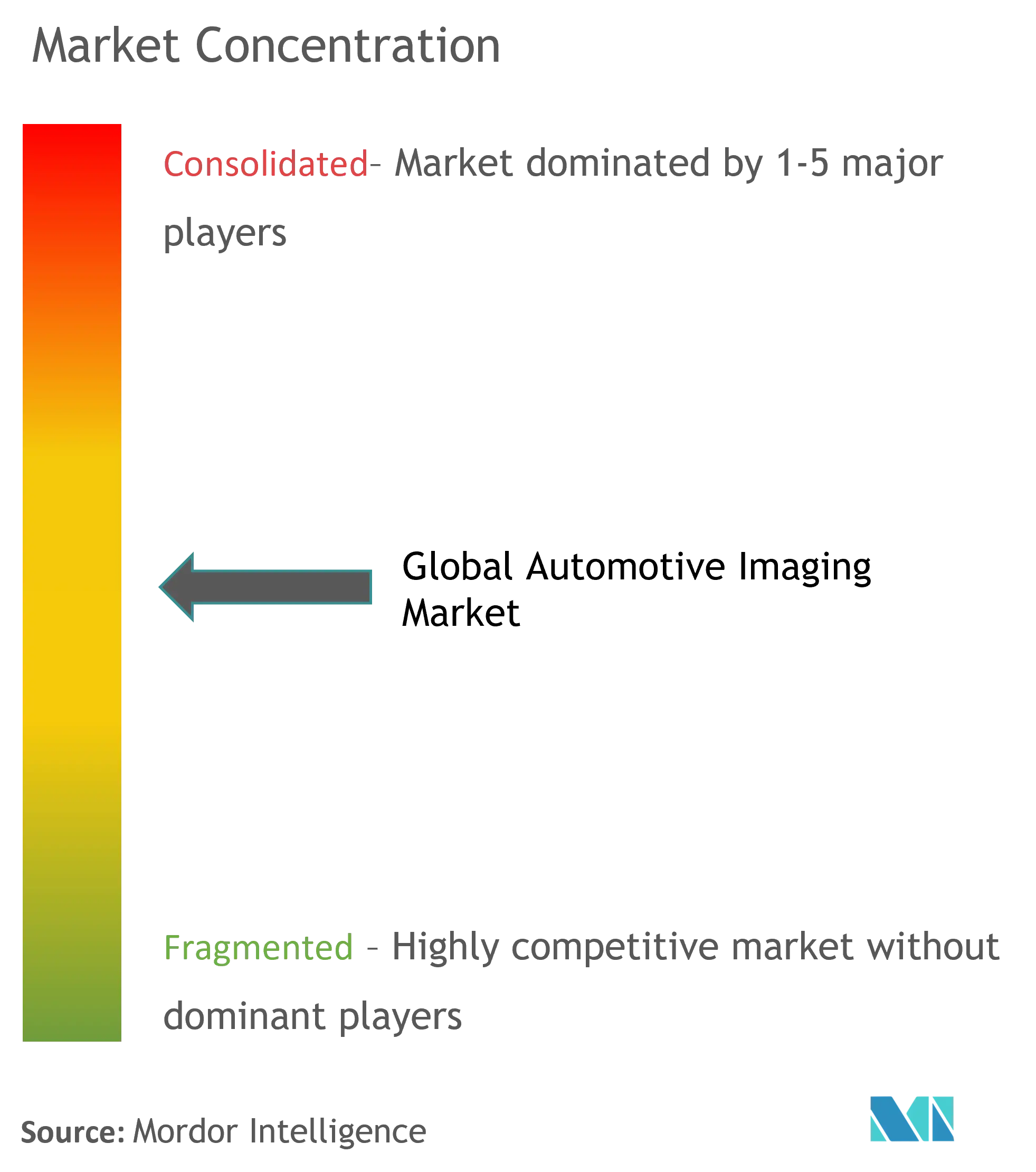Automotive Imaging Market Analysis
The Global Automotive Imaging Market is expected to register a CAGR of 12.2% during the forecast period.
- With the growth of technologies in the automotive industry that includes smart automobiles, head-mounted augmented and virtual reality (AR/VR) devices, camera drones, Internet of Things (IoT) appliances, and 3D facial-recognition systems for security and surveillance.
- The demand for Automotive advanced driver assistance systems (ADAS) and electric vehicles is growing. 3D imaging in automotive systems is a critical component of automation, aided by advances in CMOS image sensors.
- The growing trends in the automotive industry toward self-driving cars and electric vehicles are expected to be the critical drivers for newer applications of LiDAR. Self-driving cars increasingly use LiDAR sensors for generating huge 3D maps for 360° vision and for accurate information to assist in self-navigation and object detection.
- COVID-19 has had a significant influence on the global automotive industry. China is the COVID-19 hotspot that has been heavily struck by manufacturing automotive car production. Since all borders were closed, it caused supply chain difficulties. COVID-19 significantly influenced the production and sales of the automotive imaging market.
- However, the automotive imaging market started gaining momentum owing to the mandates by different countries requiring advanced safety features to be installed in the vehicles. The development of new technologies, such as night vision cameras, and the growing e-mobility, is expected to bolster the market growth.
Automotive Imaging Market Trends
Increasing Demand for Imaging and Sensor Technologies
- The automotive industry was one of the first to adopt image-based automatic inspection and analysis for process control. Machine Vision technology serves as the eye for the automotive manufacturing process. Real-time support and monitoring are feasible with imaging technologies such as conventional imaging, hyperspectral imaging, infrared imaging, line scan imaging, and 3D surface imaging. Modern sensors and advanced imaging technology can help a driverless car to drive at high speed.
- For advancements in safety and reliability, automobiles will continue to be equipped with Advanced Driver Assistance Systems (ADAS) and Driver Monitoring Systems (DMS) that notify drivers to avoid accidents.
- The parking assistance application is driving the growth of automotive imaging. The demand for manufacturing rearview cameras, along with the increasing installation of 360-degree cameras in new cars, will drive growth for the automotive imaging market moving forward.
- The real-time traffic sign recognition (TSR) systems not only help drivers to follow the traffic signals but help them follow the traffic rules. Traffic sign recognition systems in a vehicle are equipped with forward-facing cameras to detect the on-road signs. Real-time feeds from the front cameras with image processing, computer vision, and image recognition algorithms help this system recognize the traffic signs and display them on the infotainment system to be addressed by the driver.
- The latest collision warning systems work on radar, laser, and camera systems and generate audio, visual and tactical alerts in case of any possibility of collisions. These systems measure the distance, angular direction, and relative speed between the two vehicles.
- Night vision is equipped with thermal cameras and far-infrared sensors. Infrared sensors capture thermal radiations from the front of the vehicle and clearly distinguish living beings from objects, trees, and traffic signs on pedestrians and roadways. Automotive companies are researching artificial intelligence (AI) based pedestrian detection technologies, which are expected to be more precise than the existing ones.
Asia Pacific Region is Expected to Register the Fastest Growth
- In the Asia-Pacific region, there is significant growth in sales of passenger cars and commercial vehicles. For instance, China is leading in adopting the Advanced Driver-Assist System (ADAS). Thus it is propelling the Asia Pacific automotive Imaging market growth.
- The increasing penetration of luxury automotive manufacturers, such as MG Motors, Jeep, Audi AG, and BMW AG, propels the demand for advanced automotive camera systems. These components are featured in compact and mid-sized vehicles of developed countries such as Australia and Singapore, contributing to market expansion. The improvements in autonomous cars further enable camera systems to improve vehicle safety features.
- The rising number of road deaths in the area is driving the implementation of improved safety measures in automobiles, boosting market growth. These sensors are used in emergency braking systems to detect impediments, alert drivers, or stop automatically to avoid collisions. Camera systems are also employed in advanced parking assist systems to detect appropriate parking spaces and support essential steering actions.
- The key players operating in the market are Hitachi Automotive Systems Ltd., Denso Corporation, Robert Bosch GmbH, Veoneer, Continental AG, and others. These companies are developing technically equipped products to enhance the safety of vehicles.
Automotive Imaging Industry Overview
The Automotive Imaging market is moderately fragmented with the presence of various international and regional vendors. Some of the key players in the market include Continental AG, Denso Corporation, Quanergy Systems Inc., and Omnivision Technologies Inc., among others. These market players are leveraging strategic collaborative creativity to increase their market share and profitability. North America will contribute to the most significant growth of the Global Automotive Imaging market.
- April 2022 - DENSO Corporation, a major mobility provider, and United Semiconductor Japan Co., Ltd., a subsidiary of global semiconductor foundry United Microelectronics Corporation, announced a collaboration to produce power semiconductors at USJC's 300mm fab to meet rising automotive demand.
- January 2022 - OMNIVISION announced the industry's first demonstration of an 8-megapixel-based forward-looking automotive camera system at CES 2022.
Automotive Imaging Market Leaders
-
Continental AG
-
Denso Corporation
-
Omnivision Technologies Inc.
-
Quanergy Systems Inc.
-
Velodyne LiDAR Inc.
- *Disclaimer: Major Players sorted in no particular order
Automotive Imaging Market News
- May 2022 - dSPACE partnered with Velodyne to provide simulation and validation solutions in the automotive industry. The combination of Velodyne's high-performance sensors and Vella perception software, as well as dSPACE simulation tools, enables developers to test and evaluate ideas in a massively scaled variety of conditions before autonomous driving solutions start driving.
- May 2022 - Leopard Imaging announced a collaboration with OMNIVISION on AI Imaging Solutions for Autonomous Machines Leveraging OA8000 and OAX8000 Camera Video Processors. Leopard Imaging introduced a range of driving monitoring system (DMS) cameras in 2021, and the OAX8000 is poised to empower additional automotive clients. The OMNIVISION OAX8000 is a unique DMS processor with on-chip DDR3 SDRAM memory built for the automotive industry (1Gb).
Automotive Imaging Industry Segmentation
The major factors driving the growth of the automotive imaging market are an increase in the number of cars, an increase in the use of ADAS, and an increase in the trend of autonomous cars throughout the world. Companies involved in the production of these sensors spend more money on R&D, which opens up new market potential.
Global Automotive Imaging Market is segmented By Type of Product (CMOS Image Sensors, Camera Modules, Vision Processors, LiDAR, Radar) and by Geography.
| By Type of Product | CMOS Image Sensors | |||
| Camera Modules | By Application | Rear View | ||
| 360 Surround | ||||
| Forward ADAS | ||||
| Night Vision and Side Mirror Replacement | ||||
| Dashboard Camera | ||||
| Vision Processors | ||||
| LiDAR | By Application | ADAS | ||
| Robotic Cars | ||||
| Radar | By Application | Corner | ||
| Front/ Rear and Others | ||||
| By Geography | North America | |||
| Europe | ||||
| Asia-Pacific | ||||
| Rest of the World | ||||
Automotive Imaging Market Research FAQs
What is the current Global Automotive Imaging Market size?
The Global Automotive Imaging Market is projected to register a CAGR of 12.2% during the forecast period (2025-2030)
Who are the key players in Global Automotive Imaging Market?
Continental AG, Denso Corporation, Omnivision Technologies Inc., Quanergy Systems Inc. and Velodyne LiDAR Inc. are the major companies operating in the Global Automotive Imaging Market.
Which is the fastest growing region in Global Automotive Imaging Market?
Asia-Pacific is estimated to grow at the highest CAGR over the forecast period (2025-2030).
Which region has the biggest share in Global Automotive Imaging Market?
In 2025, the North America accounts for the largest market share in Global Automotive Imaging Market.
What years does this Global Automotive Imaging Market cover?
The report covers the Global Automotive Imaging Market historical market size for years: 2019, 2020, 2021, 2022, 2023 and 2024. The report also forecasts the Global Automotive Imaging Market size for years: 2025, 2026, 2027, 2028, 2029 and 2030.
Our Best Selling Reports
Global Automotive Imaging Industry Report
Statistics for the 2025 Global Automotive Imaging market share, size and revenue growth rate, created by Mordor Intelligence™ Industry Reports. Global Automotive Imaging analysis includes a market forecast outlook for 2025 to 2030 and historical overview. Get a sample of this industry analysis as a free report PDF download.

